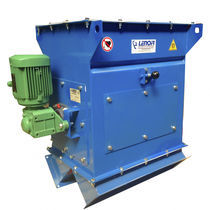The Chat Pile - World War II Ore-Dressing and Beneficiation Mill
14027 Valles Mines School Road
Once a 4-stories tall pile of pulverized red tailings left over from the WW II war effort, it now appears as a
3-acre parking lot. So how did a parking lot get the name of "The Chat Pile"?
World War II: America and The Allied Forces needed materials to fight a war
(see
"Preliminary War Minerals Report").
The Bureau of Mines in 1942, reporting to Interior Secretary Harold L. Ickes, thought
it worthwhile to send mine tailings left behind from two centuries of mining through a concentration process to get
lead and zinc for the war.
Where?
On what thereafter would be called "The Chat Pile". Dumps from mines all over the area were hauled here and piled
high for concentration even though they had been left behind for decades because the nuggets and particles were
too small for human hands to pick out and because, before 1870, no one even knew what zinc ore looked like.
Lead and barite in principle are simple to separate when they come from a Valles Mines deposit, you just wash the
clay off and what is left is the ore. Unfortunately, in doing that in 1942 with tailings,
not only were fine lead particles washed into the creek but they washed downstream from the Chat Pile for
miles.
That included zinc ore called “smithsonite” (see “Valles Mines Ore Washer” report, page 2 of 6) .
Because smithsonite resembled red clay, was very similar in weight, and bonded when wet to the
goethite (iron oxide) which also weighed and looked the same, things did not go well and a local uproar followed from people downstream
when thier creek turned red.
All three ingredients got washed downstream together, mistaken as huge amounts of waste mud. Very little zinc got
recovered from the 4-story piles loaded onto the Chat Pile. The operation was finally abandoned. To this day,
those washings can be detected in nooks and crannies of the creek bed and that century-old technology was never
used again at Valles Mines. However, fast-forward to today, if Valle Mining ever finds a way to separate the zinc ore without the mess, BHP (Broken Hill Proprietary)
estimated deposits of 54 million tons remain on the property, worth tens of millions of dollars, but waiting for an advance in technology. Mysteriously
Doe Run in 2010 announced their revolutionary new process ...
then it just disappeared from the news.
Valles Mines lead helped win the Revolutionary War, the 1780
Battle For St. Louis at Fort San Carlos, the Civil War, WW I and then WW II with the lead supplied from the Chat Pile
Beneficiator (Ruins at 14027 Valles Mines School Road 63087).
INNOVATION - When is the Future going to get here?
What has happened to mining technology since WWII? A whole lot. Valle miners never saw modern technology like electric
lights in the mines. Miners were thrilled when they could wear their then-new carbide lamps on their heads instead
of using candles. Amazingly, to this day, seeing that it is a commonplace technology for fiber-optic cable, still no
one has to this day prospected by drilling horizontally to chase lead ore veins in their mineral horizons.
Although mining at Valles Mines was forced to stop in 1918 with the Spanish Flu epidemic, never to start again, horizontal
drilling would not be discovered for another 50 years. Now you see it everyday but the Mining Company refuses to prospect
with it, even with so much to gain.
In 1942 a miner could only have imagined the invention of
Would that change mining in our world today? What would have those old miners
have done with these modern rock tools?
Who would have figured that the goethite separation problem which kept the Mining Company from success in 1942
and also from reopening its zinc operation could be solved by a magnetic separator?
 There's
lots of shopping to do for new stuff. If the goverment wanted to stimulate the economy of the
Lead Belt and SE Missouri, they could start at Valles Mines now that zinc has gone up to $2000/ton, up from $28/ton in 1942.
There's
lots of shopping to do for new stuff. If the goverment wanted to stimulate the economy of the
Lead Belt and SE Missouri, they could start at Valles Mines now that zinc has gone up to $2000/ton, up from $28/ton in 1942.